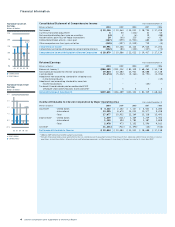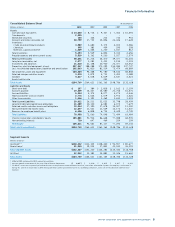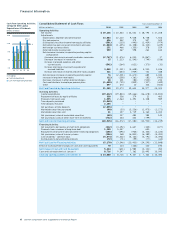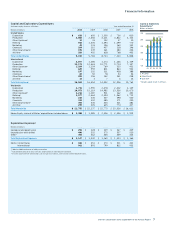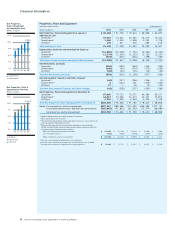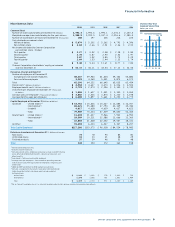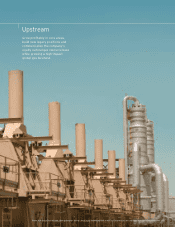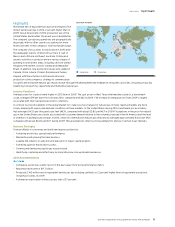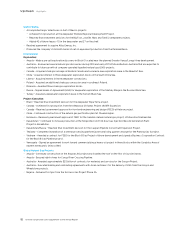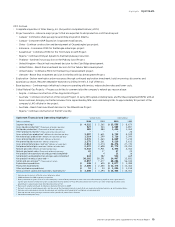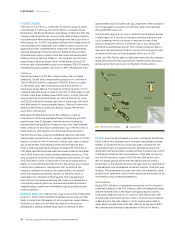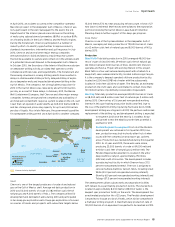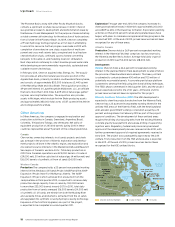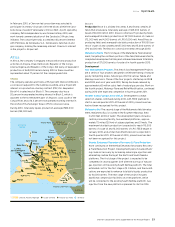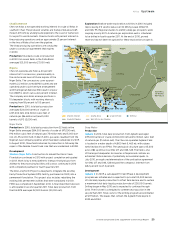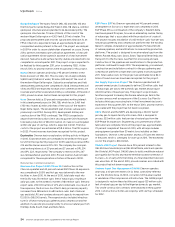Chevron 2010 Annual Report Download - page 16
Download and view the complete annual report
Please find page 16 of the 2010 Chevron annual report below. You can navigate through the pages in the report by either clicking on the pages listed below, or by using the keyword search tool below to find specific information within the annual report.
14 Chevron Corporation 2010 Supplement to the Annual Report
United States
Chevron’s U.S. portfolio is composed of a diverse group of assets
concentrated in California, the Gulf of Mexico, Louisiana, Texas,
New Mexico, the Rocky Mountains and Alaska. In February 2011, the
company added natural gas resources and shale acreage primarily
in southwestern Pennsylvania and Michigan with the acquisition of
Atlas Energy, Inc. In 2010, exploratory drilling efforts were primarily
concentrated in the deepwater Gulf of Mexico, where a successful
appraisal well was completed early in the year. The government-
imposed deepwater drilling moratorium halted drilling activities
at several exploration prospects and also impacted development
drilling activity in the Gulf of Mexico. The company was the third-
largest hydrocarbon producer in the United States during 2010,
with net daily oil-equivalent production averaging 708,000 barrels,
representing approximately one-fourth of the companywide total.
California
Operating primarily in the San Joaquin Valley, Chevron again
ranked No. 1 in net daily oil-equivalent production in California in
2010 at 199,000 barrels, composed of 178,000 barrels of crude
oil, 96 million cubic feet of natural gas and 5,000 barrels of
natural gas liquids (NGLs). The majority of the production is from
company-operated leases located in a portion of three major crude
oil fields: Kern River, Midway Sunset and Cymric. In 2010, the total
daily production from these leases was 136,000 barrels of crude
oil (133,000 net) and 14 million cubic feet of natural gas (14 million
net). With respect to these operated leases, Chevron’s interest by
field was: Kern River, 100 percent; Midway Sunset, 99 percent;
and Cymric, 100 percent.
With approximately 84 percent of the company’s crude oil
production in California considered heavy oil (typically with API
gravity lower than 22 degrees), thermal recovery techniques
utilizing steam are applied to increase oil recovery. Heat manage-
ment continues to be a major operational focus in the recovery of
these reserves, with emphasis on improved energy efficiency.
The Kern River Field, a mature steamflood operation, had total
average daily production from company-operated leases of 75,000
barrels of crude oil (74,000 net) and 2 million cubic feet of natural
gas (2 million net). The company drilled 165 infill wells at Kern
River in 2010 and planned to drill approximately 197 infill wells in
2011. More than 195 horizontal wells have been drilled in Kern River
since 2006 to more efficiently develop remaining resources. Total
daily production from these wells averaged 12,000 barrels of crude
oil (12,000 net) in 2010. A pilot project to drill horizontal wells at
depths of less than 500 feet (152 m) from the surface was initiated
in 2010 and is planned to continue into 2011. In addition, the
company continues to progress the development of increased
water and natural gas handling capacity at the field, which is
expected to be completed in third quarter 2011. Dewatering of
the reservoir from areas underlying the crude oil accumulation is
successfully reducing reservoir pressure and enabling economic
steamflooding, resulting in incremental crude oil production and
reserve additions.
Diatomite Reservoirs Chevron has crude oil resources in diatomite
reservoirs at the Cymric, McKittrick, Midway Sunset and Lost Hills
fields. Formed from the remains of microorganisms called diatoms,
diatomite is a reservoir rock with very high porosity and low
permeability, making commercial production difficult. In 2010,
approximately 42,000 barrels per day, 21 percent of the company’s
net oil-equivalent production in California, were produced from
these diatomite reservoirs.
The diatomite reservoirs at Cymric, McKittrick and Midway Sunset
contain heavy oil. A recovery technique utilizing a high-pressure
cyclic steaming process continues to improve recovery from
Cymric’s Antelope reservoir, and the process is also being used
at McKittrick and Midway Sunset. The company drilled 64 wells in
new, infill and replacement locations during 2010 and plans to drill
an additional 56 wells in these diatomite reservoirs in 2011.
In the Lost Hills Field (a light-oil, diatomite reservoir), the company
drilled 25 production wells during 2010. Waterflood technology is
being used to improve recovery of the field’s hydrocarbons.
Elk Hills An active development program continued at the Elk Hills
Field, in which the company has an average nonoperated working
interest of 23 percent in four producing zones. During 2010, 197
development wells (including producers and injectors) and one
delineation well were drilled, including drilling in shale zones, which
continued to extend producing boundaries. Total daily production
was 44,000 barrels of crude oil (10,000 net), 283 million cubic
feet of natural gas (65 million net) and 18,000 barrels of NGLs
(4,000 net). In the Shallow Oil Zone, nitrogen injection optimization
continued and a second alkaline surfactant polymer flood pilot was
initiated. These enhanced-recovery activities are intended to allow
production of additional crude oil and natural gas that would not be
recoverable using conventional methods.
Gulf of Mexico
During 2010, net daily oil-equivalent production for the company’s
combined interests in the Gulf of Mexico shelf and deepwater areas
and the onshore fields in the region averaged 260,000 barrels,
composed of 169,000 barrels of crude oil, 445 million cubic feet
of natural gas and 17,000 barrels of NGLs. Chevron has an interest
in 686 leases in the Gulf of Mexico, 404 of which are located in
water depths greater than 1,000 feet (305 m). At the end of 2010,
the company was the largest leaseholder in the Gulf of Mexico.
Upstream United States
San
Joaquin
Valley
California
Bakersfield
Lost Hills
Midway
Sunset
Cymric and
McKittrick
Kern River
Elk Hills
Taft
Chevron Activity Highlight Crude Oil Field


